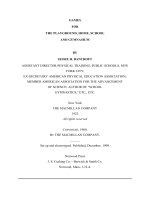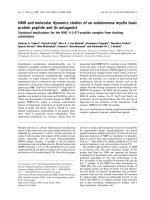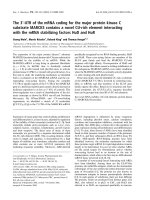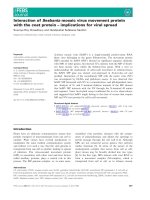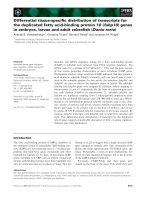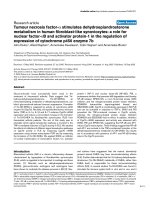Protein Shakes for the Brain 90 Games and Exercises to Work Your Mind''s Muscle to the Max 90 Games and Exercises to Work Your Mind''s Muscle to the Max
Bạn đang xem bản rút gọn của tài liệu. Xem và tải ngay bản đầy đủ của tài liệu tại đây (8.92 MB, 142 trang )
Protein
shakes
for the
Brain
This page intentionally left blank
Protein
shakes
for the
Brain
Michel Noir, Ph.D. & Bernard Croisile, M.D., Ph.D.
New
YorkChicago
Chicago San
SanFrancisco
Francisco Lisbon
City
New
York
Lisbon London
London Madrid
MadridMexico
Mexico
City
Milan New Delhi San Juan Seoul Singapore Sydney Toronto
Milan New Delhi San Juan Seoul Singapore Sydney Toronto
Copyright © 2009 by HAPPYneuron, Inc. All rights reserved. Except as permitted under the United
States Copyright Act of 1976, no part of this publication may be reproduced or distributed in any
form or by any means, or stored in a database or retrieval system, without the prior written permission of the publisher.
ISBN: 978-0-07-162856-3
MHID: 0-07-162856-8
The material in this eBook also appears in the print version of this title: ISBN: 978-0-07-162836-5,
MHID: 0-07-162836-3.
All trademarks are trademarks of their respective owners. Rather than put a trademark symbol after
every occurrence of a trademarked name, we use names in an editorial fashion only, and to the
benefit of the trademark owner, with no intention of infringement of the trademark. Where such
designations appear in this book, they have been printed with initial caps.
McGraw-Hill eBooks are available at special quantity discounts to use as premiums and sales
promotions, or for use in corporate training programs. To contact a representative please visit the
Contact Us page at www.mhprofessional.com.
TERMS OF USE
This is a copyrighted work and The McGraw-Hill Companies, Inc. (“McGraw-Hill”) and its
licensors reserve all rights in and to the work. Use of this work is subject to these terms. Except as
permitted under the Copyright Act of 1976 and the right to store and retrieve one copy of the work,
you may not decompile, disassemble, reverse engineer, reproduce, modify, create derivative works
based upon, transmit, distribute, disseminate, sell, publish or sublicense the work or any part of it
without McGraw-Hill’s prior consent. You may use the work for your own noncommercial and
personal use; any other use of the work is strictly prohibited. Your right to use the work may be
terminated if you fail to comply with these terms.
THE WORK IS PROVIDED “AS IS.” McGRAW-HILL AND ITS LICENSORS MAKE NO GUARANTEES OR WARRANTIES AS TO THE ACCURACY, ADEQUACY OR COMPLETENESS OF
OR RESULTS TO BE OBTAINED FROM USING THE WORK, INCLUDING ANY
INFORMATION THAT CAN BE ACCESSED THROUGH THE WORK VIA HYPERLINK OR
OTHERWISE, AND EXPRESSLY DISCLAIM ANY WARRANTY, EXPRESS OR IMPLIED,
INCLUDING BUT NOT LIMITED TO IMPLIED WARRANTIES OF MERCHANTABILITY OR
FITNESS FOR A PARTICULAR PURPOSE. McGraw-Hill and its licensors do not warrant or
guarantee that the functions contained in the work will meet your requirements or that its operation
will be uninterrupted or error free. Neither McGraw-Hill nor its licensors shall be liable to you or
anyone else for any inaccuracy, error or omission, regardless of cause, in the work or for any
damages resulting therefrom. McGraw-Hill has no responsibility for the content of any information
accessed through the work. Under no circumstances shall McGraw-Hill and/or its licensors be liable
for any indirect, incidental, special, punitive, consequential or similar damages that result from the
use of or inability to use the work, even if any of them has been advised of the possibility of such
damages. This limitation of liability shall apply to any claim or cause whatsoever whether such
claim or cause arises in contract, tort or otherwise.
Contents
Why Does My Brain Need a Protein Shake? . . . . . . vii
Just Starting Out
Easy Exercises . . . . . . . . . . . . . . . . . . . . . 1
Getting Fit
Medium Exercises. . . . . . . . . . . . . . . . . . . 39
Iron Man
Hard Exercises . . . . . . . . . . . . . . . . . . . . 77
Solutions . . . . . . . . . . . . . . . . . . . . . . . 117
This page intentionally left blank
vii
Why Does My Brain
Need a Protein Shake?
Increasingly, scientific evidence tells us that our minds don’t
have to deteriorate as we age—there are things we can do now
to dramatically increase the probability of staying mentally and
physically fit throughout our lives. This is good news indeed,
because mental fitness and agility are so directly connected to
a good quality of life. Physical exercise, good nutrition, social
connection with others, and mental stimulation all play important
parts in ensuring that our brains remain sharp and agile.
Over the past 25 years, scientists and physicians affiliated with
medical schools and universities all over the world have followed
and tested large groups of people to try to understand why some
people stay mentally sharp over the span of their lives and other
people don’t. As a result, we now have a significant body of
scientific research in an area called “cognitive reserve.” Cognitive
reserve involves the brain’s ability to create new neural pathways
and connections that can be used as a mental savings account, a
reserve to be drawn upon in times of need. The research supports
the hypothesis that many people continue to operate at a high
mental level throughout their lives by building these brain reserves.
Several studies support the hypothesis of cognitive reserve and
reinforce the importance of good physical health in keeping the
brain fit. One such study is the famous Nun’s Study described in
Aging with Grace, in which Dr. David Snowdon, a neurologist, and
his colleagues followed 700 nuns over more than 20 years. Two
extremely important findings have come out of this study: first,
there is a link between vascular episodes, such as stroke and heart
attack, and Alzheimer’s and dementia; and second, stimulating
intellectual activity can provide protection from many types of
cognitive decline.
viii
— W h y D o e s M y B r a i n N e e d a P r o t e i n S h a k e ? —
Other ongoing studies have come to similar conclusions. The
Bronx Aging Study, led by neurologist Dr. Joe Verghese and
published in The New England Journal of Medicine, has followed
almost 500 people for more than 20 years, observing what they
actually do in their lives and what the relationship is between these
choices and brain health. The research has found that people who
participated in mentally stimulating activities, such as interactive
games and dancing, four times a week had a 65 to 75 percent better
probability of remaining sharp than those who did not participate
in these activities.
Dr. David Bennett at Rush University Medical Center has recently
come to the same conclusion after following more than 2,000 people
for years. Over time, 134 people died. None of them had been
diagnosed with Alzheimer’s or even mild cognitive decline. But 36
percent of them had the severe tangles and plaques of Alzheimer’s.
This positive news reinforces the “use it or lose it” philosophy;
these people had built up enough brain reserves to show no clinical
signs of disease, meaning they still exhibited good thinking skills.
We encourage you to challenge yourself to learn at every
opportunity by learning a new language or a new musical
instrument or new and more complex tunes with an old one,
reading, dancing, or taking a class. These are all effective tools to
keep your mind sharp. But sometimes your brain needs a quick
shot in the arm, a quick burst of energy—that’s why we developed
Protein Shakes for the Brain. Doing the puzzles in this book is a
quick and easy way to give your mind’s muscle a little boost and
keep those neural pathways growing.
tarting O
S
t
ut
Jus
Easy
Exercises
This page intentionally left blank
— E A S Y e x e r c i ses —
3
Warm-Ups
Do you know the answers to these common-knowledge questions?
Shake up your brain and find out.
1. Who wrote the short-story “The Fall of the House of Usher”?
a. Emily Brontë
b. D. H. Lawrence c. Edgar Allan Poe
2. Which type of ship did Christopher Columbus use to sail
to America?
a. schooner
b. caravel
c. trimaran
3. Which sport is Kobe Bryant famous for?
a. swimming
b. karate
c. basketball
4. Which one of these snakes is not deadly for humans?
a. viper
b. cobra
c. rat snake
5. Which country does tiramisu, a delicious chocolate and coffee
cake, come from?
a. Italy
b. Spain
c. Romania
6. What was the name of Sherlock Holmes’s famous friend?
a. James
b. William
c. Watson
7. What color do you get when you mix yellow and blue together?
a. purple
b. red
c. green
8. What is celebrated in the United States on July 4th?
a. The approval of the Declaration of Independence
b. The signing of the Declaration of Independence
c. The first battle in the Revolutionary War
4
— p r o t e i n s h a k es f o r t h e B r a i n —
Warm-Ups
Do you know the answers to these common-knowledge questions?
Shake up your brain and find out.
1. Which one of these is not an insect?
a. spider
b. flea
c. butterfly
2. Who created the beloved Simpsons cartoon family?
a. Matt Groening b. Bob Kane
c. Stan Lee
3. Which one of these characters did Walt Disney not create?
a. Donald Duck
b. Pluto
c. Popeye the Sailor
4. During which century did Mozart live?
a. 17th
b. 18th
c. 19th
5. Which famous battle did General Custer die at?
a. Bull Run
b. Little Bighorn
c. Waterloo
6. Which country originated the sauna?
a. Finland
b. Norway
c. Sweden
7. Which animal is considered man’s best friend?
a. cat
b. cow
c. dog
8. Who directed the movie Jurassic Park?
a. Martin Scorsese b. Steven Spielberg c. Robert Altman
— E A S Y e x e r c i ses —
Daily Workout
Can you remember in which year these historical events
occurred?
1. The first man on the moon
2. The sinking of the Titanic
3. The Boston Tea Party
4. The Wall Street crash
5. The discovery of America by Christopher Columbus
6. The end of the Vietnam War
7. The fall of the Berlin Wall
8. The Declaration of Independence
5
6
— p r o t e i n s h a k es f o r t h e B r a i n —
Daily Workout
Can you remember in which year these historical events
occurred?
1. The start of World War II
2. The battle of the Little Bighorn
3. The Chernobyl disaster
4. The death of Princess Diana
5. The Los Angeles Olympic Games
6. The start of Ronald Reagan’s presidency
7. The crowning of Queen Elizabeth II of the United Kingdom
8. The death of William Shakespeare
7
— E A S Y e x e r c i ses —
Interval Training
Can you put back together the 20 words that have been split into
two syllables and spread across the grid? Watch out, each syllable
can be used only once!
Tip: All words belong to the category “Fruits and Vegetables.”
fruit
ly
sweet
beet
nach
pi
pars
ca
bread
go
me
dur
chee
ki
per
pars
kin
on
lon
rrot
man
wi
root
le
quat
ion
barb
mon
ley
tuce
ckle
kum
pump
corn
pep
rhu
nip
let
ban
spi
Your answers:
1.
11.
2.
12.
3.
13.
4.
14.
5.
15.
6.
16.
7.
17.
8.
18.
9.
19.
10.
20.
8
— p r o t e i n s h a k es f o r t h e B r a i n —
Interval Training
Can you put back together the 20 words that have been split into
two syllables and spread across the grid? Watch out, each syllable
can be used only once!
Tip: All words belong to the category “Capital Cities.”
Lon
A
Li
lin
rich
ney
Ma
ran
Pa
blin
lo
Bei
Zu
ro
thens
War
Os
lin
jing
saw
don
Ber
Nas
noi
Teh
drid
to
Syd
ma
rain
Tal
Bah
Mos
sau
Cai
cow
Ha
Qui
Du
ris
Your answers:
1.
11.
2.
12.
3.
13.
4.
14.
5.
15.
6.
16.
7.
17.
8.
18.
9.
19.
10.
20.
9
— E A S Y e x e r c i ses —
Lateral Rows
For each row, circle which of the three words is spelled correctly.
1. insolvancy
insolvency
insulvency
2. valuable
valewable
valluable
3. accordance
acordance
accordence
4. occurrence
ocurrence
occurrance
5. insaucing
insourcing
insourssing
6. literature
litterature
literiture
7. oceanollogy
oceanology
oshenology
8. manigement
managemant
management
9. yogourt
yoggurt
yogurt
10. trainee
trainy
trainnee
11. occupency
occupancy
occupenssy
12. hazard
hayzard
hazad
13. occlusive
oclusive
occlussive
14. intergrate
integreat
integrate
15. yungster
youngster
youngsta
16. azure
azzure
azurre
10
— p r o t e i n s h a k es f o r t h e B r a i n —
Lateral Rows
For each row, circle which of the three words is spelled correctly.
1. vitamin
vittamin
vitammin
2. babywhere
babywear
babiwear
3. dabbler
debbler
dabler
4. tobaco
tobbaco
tobacco
5. weakend
weekend
weekkend
6. welth
wealth
wellth
7. fruitful
frootful
fruitfull
8. jockee
jocky
jockey
9. abilitty
abillity
ability
10. beach
bich
beatch
11. ozon
ozone
osone
12. hiccup
hickup
hicup
13. geneealogy
geneallogy
genealogy
14. varsitty
varsity
varsety
15. junior
joonior
junier
16. docter
doctor
docktor
— E A S Y e x e r c i ses —
Bio-Feedback
Whose life is described below?
I was born on July 6, 1907, in my parents’ house “La Casa Azul”
in Coyoacán, Mexico. My father, who died in 1941, was born in
Pforzheim, Germany, and was the son of a painter and goldsmith.
Even though my parents’ marriage was rather unhappy, they still had
four daughters. I am the third.
In 1913, I was affected by poliomyelitis and my right leg became
thinner than the left one. I always wore long skirts to hide this.
I suffered serious injuries and fractures in a bus accident on
September 17, 1925, and had to undergo 35 operations. Following
the accident I turned to painting, which helped me enormously
during my recovery. My paintings are full of color and greatly
influenced by the indigenous Mexican culture. Monkeys, a symbol
of Mexican mythology, often recur, as well as Christian and Jewish
themes, and I liked to combine tradition and surrealism. My selfportraits, in particular, were a major part of my work.
In 1929, I married the famous Mexican painter Diego Rivera,
whose work I had always admired. Our marriage was stormy, and
we both had extramarital relationships, one of mine being with
Leon Trotsky.
In 1939, I was invited to France by André Breton and given
the opportunity to do an exhibition. As the first painting by a
20th-century Mexican artist ever purchased by the internationally
renowned Louvre, “The Frame,” one of my seminal works, was
displayed at the exhibition.
I died from pulmonary embolism on July 13, 1954.
11
12
— p r o t e i n s h a k es f o r t h e B r a i n —
Bio-Feedback
Whose life is described below?
I was born on March 2, 1931, in Privolnoye, Russia, and faced a
tough childhood under Stalin’s regime. I lived through World War
II, and my experience during the German occupation of Russia
between August 1942 and February 1943 had a great impact on my
perception of life and my professional career.
In September 1950, I started studying law at Moscow University
and later joined the Communist Party of the Soviet Union (CPSU)
as a candidate member. I also met my future wife, Raisa, in
Moscow. We married in 1953 and moved back to my home region
after my graduation in 1955.
I was made a member of the CPSU in 1971 and moved on to the
politburo in 1979, with full membership in 1980. My positions gave
me many traveling opportunities, and it was on one such trip that I
met the British Prime Minister Margaret Thatcher in 1984. On March
11, 1985, I was elected General Secretary of the Communist Party.
I was the first party leader born after the revolution and I tried to
reform the party. In 1988, I announced the decision to abandon the
Brezhnev Doctrine and to allow the countries of the Eastern bloc to
develop freely.
In March and April 1989, I was elected Chairman of the Supreme
Soviet and thus head of state during the very first free election since
1917 in the Soviet Union. I had close relationships with leaders like
President Ronald Reagan and Margaret Thatcher. I was awarded
the Otto Hahn Peace Medal in Gold that same year and the Nobel
Peace Prize on October 15, 1990.
On March 15, 1990, I was elected the first and the only President
of the Soviet Union by the Congress of People’s Deputies. After a
great crisis, I agreed to dissolve the Soviet Union on December 17,
1991, and I resigned from my position on December 25. I am the
most famous person with naevus flammeus, a crimson birthmark
on top of my head.
— E A S Y e x e r c i ses —
The Proper Form
Pay attention to the shape and position of the six icons in the
grid. Then turn the page and continue the exercise.
13
14
— p r o t e i n s h a k es f o r t h e B r a i n —
The Proper Form
Can you place all six elements correctly back into the grid?
Tip: The fields where an item is supposed to be are colored in blue!
— E A S Y e x e r c i ses —
The Proper Form
Pay attention to the shape and position of the six icons in the
grid. Then turn the page and continue the exercise.
15
16
— p r o t e i n s h a k es f o r t h e B r a i n —
The Proper Form
Can you place all six elements correctly back into the grid?
Tip: The fields where an item is supposed to be are colored in blue!

